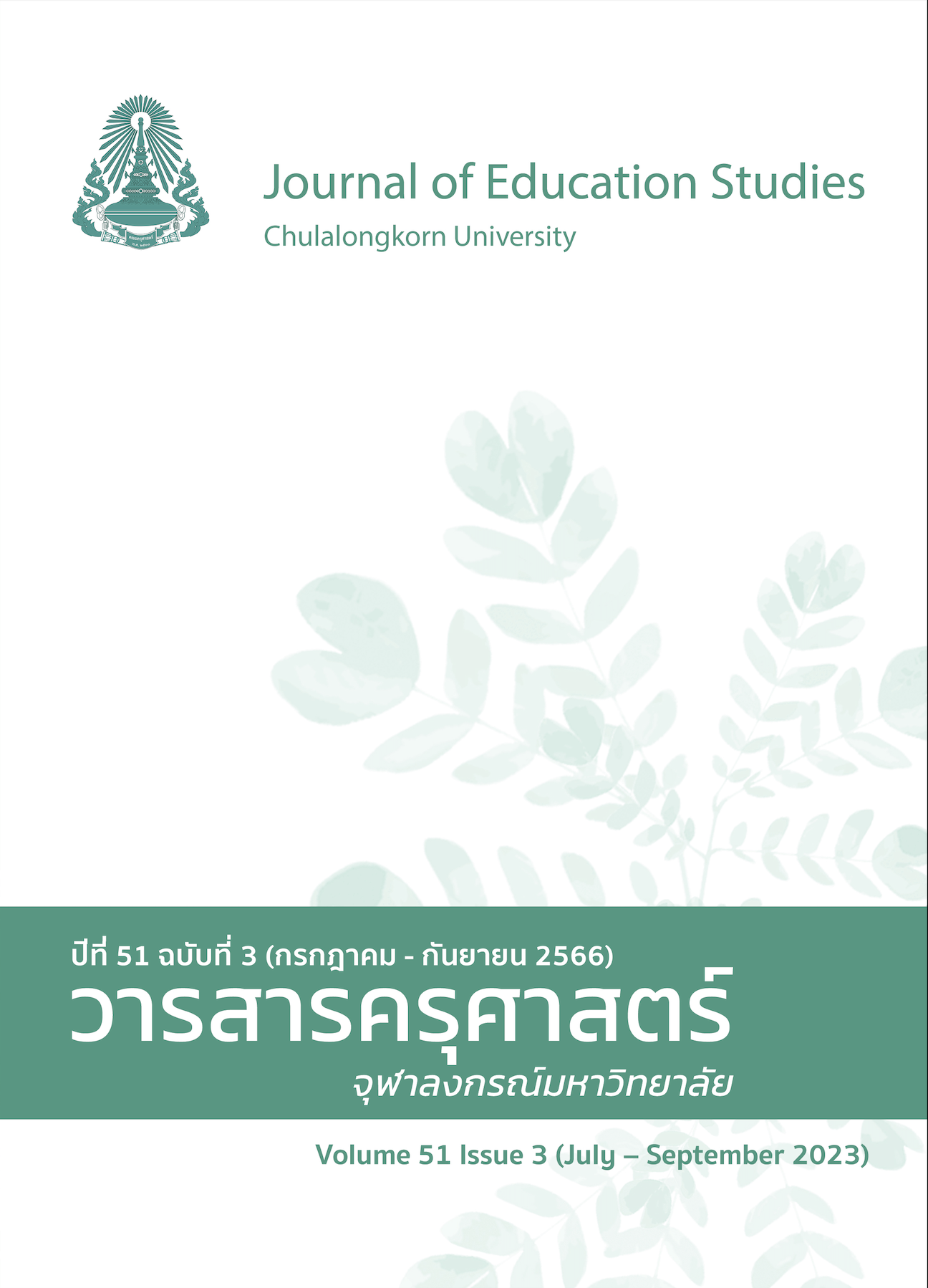The Effects of Using Learning Activities Based on Design Thinking Process with Family and Community Engagement to Enhance Learning and Innovation Skills for Grade 11 Students
DOI:
https://doi.org/10.14456/educu.2023.27Keywords:
learning activities, design thinking process, family and community engagement, learning and innovation skillsAbstract
The purposes of this study were to study grade 11 students’ learning and innovation skills after implementing learning activities based on design thinking process with family and community engagement. Furthermore, it compared the Grade 11 students’ learning and innovation skills between post-test and the criterion (70 percent). The study also aimed to investigate the Grade 11 students’ satisfaction towards the learning activities based on design thinking process with family and community engagement. This research used a quasi-experimental research methodology with a one group posttest only design. The samples consisted of 35 Grade 11 students, who were divided into 10 groups. There were 3-5 students in each group. The samples were selected through purposive sampling technique from Chalermkwansatree School in the first and second semesters of 2021 academic year. Lesson plans; a rubric-based assessment of learning and innovation skills form; and satisfaction assessment questionnaires constituted the research instrument. Percentage, Mean, Standard deviation: SD, and a One-sample t-test were used for data analysis. The findings revealed that 5 groups (50 percent) of students were in the high level of learning and innovation skills, 4 groups (40 percent) were in the highest level of learning and innovation skills, and the remaining group (10 percent) learning and innovation skills was at the intermediate level. The Grade 11 students’ learning and innovation skills were enhanced and significantly higher than the criterion (70 percent) at .05 level; while, students’ satisfaction towards learning activities was at the high level (Mean = 4.27, SD = 0.16).
References
ภาษาไทย
พิชญา กล้าหาญ และวิสูตร โพธิ์เงิน. (2564). การพัฒนากิจกรรมการเรียนรู้ตามแนวคิดกระบวนการคิดเชิงออกแบบร่วมกับการจัดการเรียนรู้โดยใช้โครงงานเป็นฐาน เพื่อส่งเสริมความเป็นนวัตกรของนักเรียนชั้นมัธยมศึกษาปีที่ 4. วารสารครุศาสตร์จุฬาลงกรณ์มหาวิทยาลัย, 49(2), 1-16.
พิชญา ดีมี. (2559). การพัฒนาแนวทางการประเมินทักษะการเรียนรู้และนวัตกรรมของผู้เรียนตามแนวคิดการประเมินผู้เรียนในศตวรรษที่ 21 (วิทยานิพนธ์ปริญญาดุษฎีบัณฑิต, มหาวิทยาลัยนเรศวร). ThaiLIS. https://tdc.thailis.or.th/tdc/search_result.php
วิจารณ์ พานิช. (2555). วิถีสร้างการเรียนรู้เพื่อศิษย์ในศตวรรษที่ 21. กรุงเทพฯ: มูลนิธิสดศรี-สฤษดิ์วงศ์.
ศูนย์สร้างสรรค์งานออกแบบ. (2560). การคิดเชิงออกแบบ: เรียนรู้ด้วยการลงมือทำ. Retrieved from
http://resource.tcdc.or.th/ebook/Design.Thingking.Learning.by.Doing.pdf
สวภพ เทพกสิกุล. (2559). แนวทางการบริหารกิจการนักเรียนตามแนวคิดการเสริมสร้างความยึดมั่นผูกพันระหว่างโรงเรียน ครอบครัว และชุมชนของโรงเรียนมัธยมศึกษา สำนักงานเขตพื้นที่การศึกษามัธยมศึกษา เขต 10 (วิทยานิพนธ์ปริญญามหาบัณฑิต, จุฬาลงกรณ์มหาวิทยาลัย). ThaiLIS. https://tdc.thailis.or.th/tdc/search_result.php
สำนักงานเลขาธิการสภาการศึกษา. (2560). แผนการศึกษาแห่งชาติ พ.ศ.2560-2579. กรุงเทพฯ: พริกหวานกราฟฟิค.
สำนักงานเลขาธิการสภาการศึกษา. (2561). สภาวะการศึกษาไทยปี 2559/2560 แนวทางการปฏิรูปการศึกษาไทยเพื่อก้าวสู่ยุค Thailand 4.0. กรุงเทพฯ:
พริกหวานกราฟฟิค.
ภาษาอังกฤษ
Battelle for Kids. (2019). Partnership for 21st Century Learning: A Network of Battelle for Kids. Retrieved from https://www.battelleforkids.org/networks/p21.
Berg, C. A., Melaville, A., & Blank, J. M. (2006). COMMUNITY & FAMILY ENGAGEMENT PRINCIPALS SHARE WHAT WORKS. Washington, DC: Institute for Educational Leadership.
Brabrand, C., and Dahl, B. (2009). Using the SOLO taxonomy to analyze competence progression of university science curricula. Higher Education, 58(4). 531–549.
Department of Education, Queensland Government. (2020). Advancing Partnerships Parent and Community Engagement Framework. Retrieved from https://education.qld.gov.au/parents/community-engagement/Documents/pace-framework.pdf
IDEO.org. (2015). The Field Guide to Human-Centered Design. Canada: Design Kit.
Potter, M. K., and Kustra, E. (2012). A Primer on Learning Outcomes and the SOLO Taxonomy. Centre for Teaching and Learning: University of Windsor.
Shumow, L., and Schmidt, J. A. (2014). Parent engagement in science with ninth graders and with students in higher grades. School Community Journal, 24(1), 17–36.
The Stanford d.school Bootcamp Bootleg. (2010). D.school bootcamp bootleg: Institute of design at Standford. Retrieved from http://dschool.stanford.edu/wpcontent/uploads/2011/03/BootcampBootleg2010v2SLIM.pdf
Yang, C. M., & Man, H. T. (2018). Applying Design Thinking Process in Student’s Project: A case of EGF Products. MATEC Web of Conferences, 201(04003), 1-13. https://doi.org/10.1051/matecconf/201820104003.
Downloads
Published
How to Cite
Issue
Section
License

This work is licensed under a Creative Commons Attribution-NonCommercial-NoDerivatives 4.0 International License.




